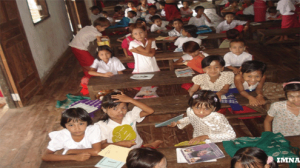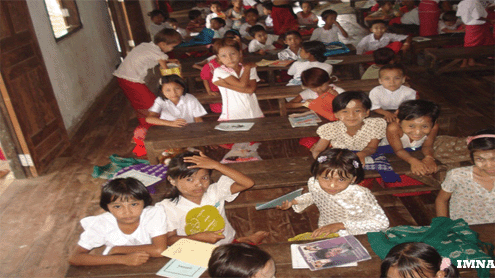
By LAWI WENG : The All Mon Regions Democracy Party (AMDP), which won 16 seats in Mon State during the elections in November, will make a request from the new Burmese government to allow Mon language teaching at all Burmese schools in Mon state.
Speaking to The Independent Mon News Agency on Thursday, Nai Ngwe Thein, the chairman of the AMDP, said, “We will ask the new government to allow our language to run at primary schools in Mon State. This is our main goal.”
There are around three million Mon people in the southern part of Burma who have never been taught Mon language reading and writing at the Burmese schools. They learn Burmese without being taught their mother language.
“Mon literature and culture are very important to the Mon people. Our language must be taught to our people. The new government needs to recognize this,” said Nai Ngwe Thein.
AMDP leaders have discussed the need for all Mon students to learn Mon language during primary school. If Mon language teaching is allowed, this will be the first time for many Mon children to have the opportunity to learn their mother language at the Burmese government schools. AMDP party members have professed their belief that it is essential for all Mon children to learn their mother language first before learning Burmese.
“We will ask for Mon language to be taught first, and after that, the students can begin to learn Burmese and other languages,” Nai Ngwe Thein said.
Nai Santhorn, the chairman of the Mon Unity League (MUL), and the man who partly initiated a Mon teaching curriculum at a Thai national school in Sangklaburi, Thailand, in which a large Mon population resides, stated that all Mon children need to learn how to read and write their mother language first. He believes it gives them a basic learning foundation, making it easier to learn other languages once they can read and write their own.
“I have noticed that many Mon children in Sangklaburi have better reading and writing skills once they have learned how to read and write in their mother language,” he said.
The AMDP leaders explain that they will not accept a “no” from the Burmese government or any acquiescence that only allows Mon language teaching as an after school program. They demand that the government enacts a Mon language curriculum during regular school hours.
Before 1995, most Mon children living were only able to learn Mon at the Buddhist Monasteries, as the Burmese military junta banned Mon language at the Burmese government schools.
Once the New Mon State Party (NMSP) signed a ceasefire agreement with the Burmese government in 1995, the NMSP made an informal understanding with the military junta which allowed Mon curriculum to be taught as an integral part of the curriculum for some of the Burmese government schools in Mon State run by the NMSP. Education in NMSP controlled areas is run by the Mon National Education Department (MNED).
According to MNED statistics from 2008, there are 157 schools teaching Mon language in Mon State while 114 schools offer a mixed curriculum of both Burmese and Mon language lessons.
Though a Burmese state-run show on Burmese television promotes the various ethnic cultures and literature of Burma, Mon observers have explained that Mon cultural activities have been banned and forced to assimilate to Burmese culture.
The Burmese military regime has attempted to control Mon literature and culture for many years in Burma. In 2007, the regime changed the name of the Mon National Museum to the “National Museum.”
In November 2008, the regime banned Mon curriculum from 3,000 primary and secondary school students at 30 schools in Thaton District.
Meanwhile, the MNED has been unable to conduct its education projects since relations soured between the NMSP and the military regime after the NMSP refused to serve in the military Burmese border guard forces (BGF).
Mon language descended from ancient Indian Brahmin script. Mon is one of the oldest and most influential languages in the region, its alphabet forming the foundation for Burmese, Thai, Khmer and Laotian scripts.

